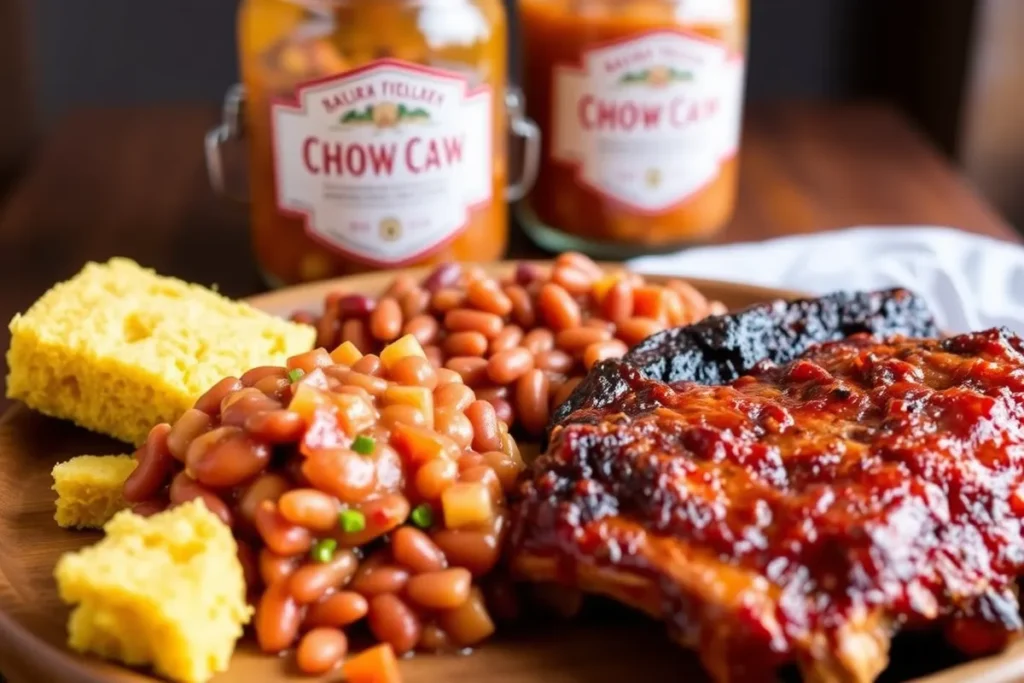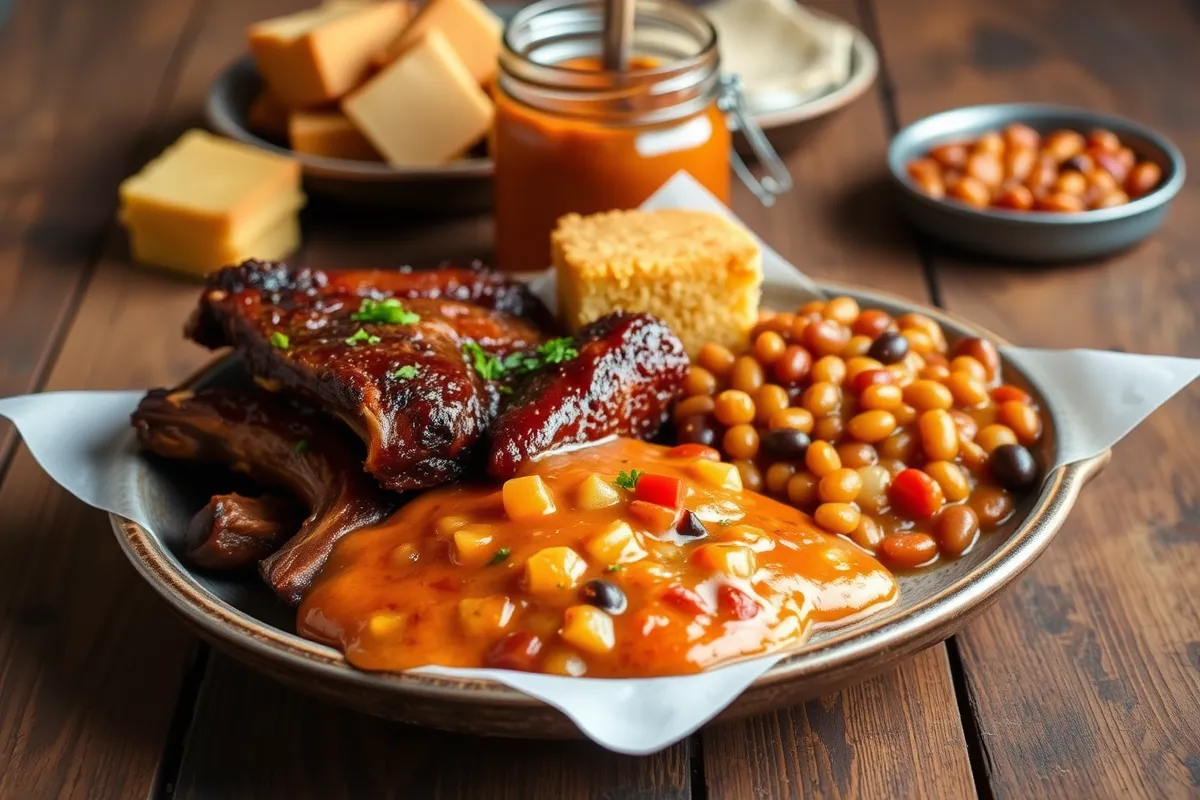Dive into the fascinating world of chow chow, a tangy, vegetable-packed relish that offers vibrant flavors and unmatched culinary versatility. Its journey started with humble origins and grew into a culinary legacy through meticulous preparation methods. This article reveals its core ingredients, preparation techniques, health benefits, and more, ensuring you discover everything about what chow chow is made of!
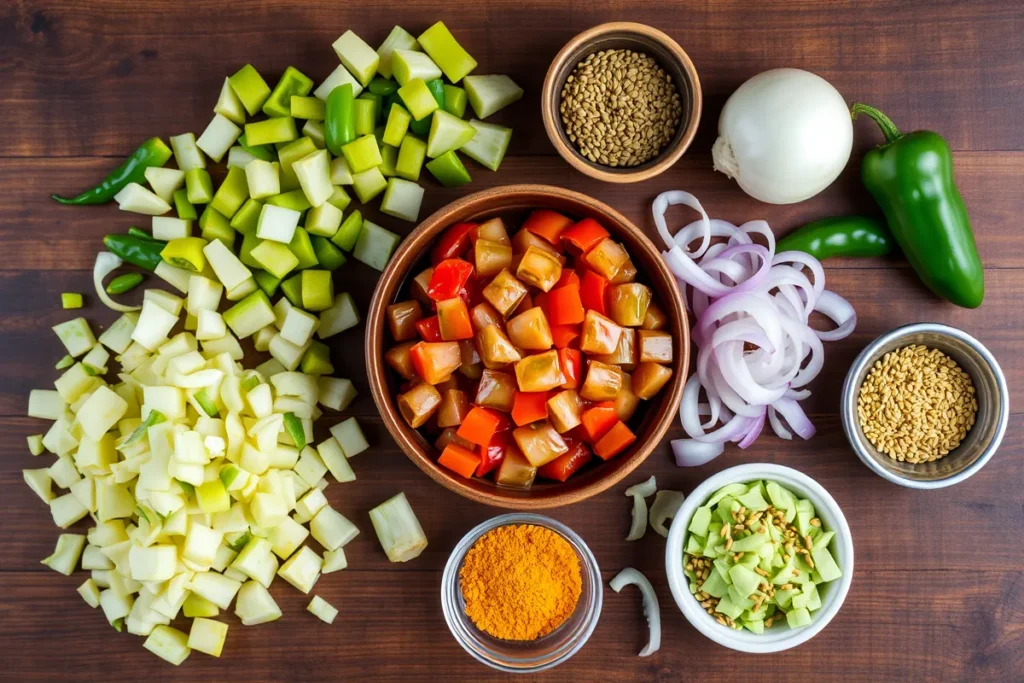
Introduction and Overview
Understanding : Ingredients and Origins
Chow chow is a tangy, flavorful relish with a history as rich as its taste. It’s not just a treat for the palate but also a window into regional culinary traditions. This cabbage-based condiment has long been a staple in Southern cooking, although its appeal spans borders and cuisines. But what is chow chow made of exactly? It’s a delightful medley of pickled vegetables, spices, and vinegar that creates an explosion of flavor.
This relish often serves as a condiment, but it’s also a star ingredient in various recipes, adding a zesty kick to classic dishes. While some love its tangy sweetness, others cherish its spiced complexity. No matter your preference, chow chow is a blend of history and culinary art. Whether paired with beans, burgers, or a fresh slice of bread, it’s a versatile delight that has stood the test of time.
What is Chow Chow?
At its core, chow chow is a pickled vegetable relish, and it’s as simple—or complex—as its maker desires. The base typically includes green tomatoes, cabbage, onions, and bell peppers, but variations abound. Traditionally, the vegetables are finely chopped, salted, and combined with a flavorful brine made of vinegar, sugar, and spices like mustard and celery seeds.
Every bite of chow chow tells a story, often regional or cultural. In the Southern United States, it’s a tangy-sweet staple, while Northern variations might emphasize a spicier or sour flavor. Even Canadian Maritime chow chow carries its unique spin, reflecting the local tastes of its communities.
Historical Background of Chow Chow Relish
The exact origins of chow chow are a bit of a mystery, but food historians often trace it back to the pickling traditions brought by immigrants. Some suggest it has ties to Chinese pickled vegetables—with the name “chow chow” being derived from the Cantonese word for “mixed.” Others believe it has roots in European cuisine, evolving as settlers adapted recipes to include local produce.
What’s certain is that this relish became a preservation method born of necessity. Seasonal vegetables were harvested in abundance and pickled to last through winter. Over time, the recipe transformed from a practical solution into a beloved culinary staple. It became a symbol of resourcefulness and creativity, showcasing the ability to craft something extraordinary from everyday ingredients.
In modern times, chow chow is celebrated not just for its taste but also for its cultural significance. From potlucks to family feasts, it continues to bring people together, offering a comforting taste of home and heritage.
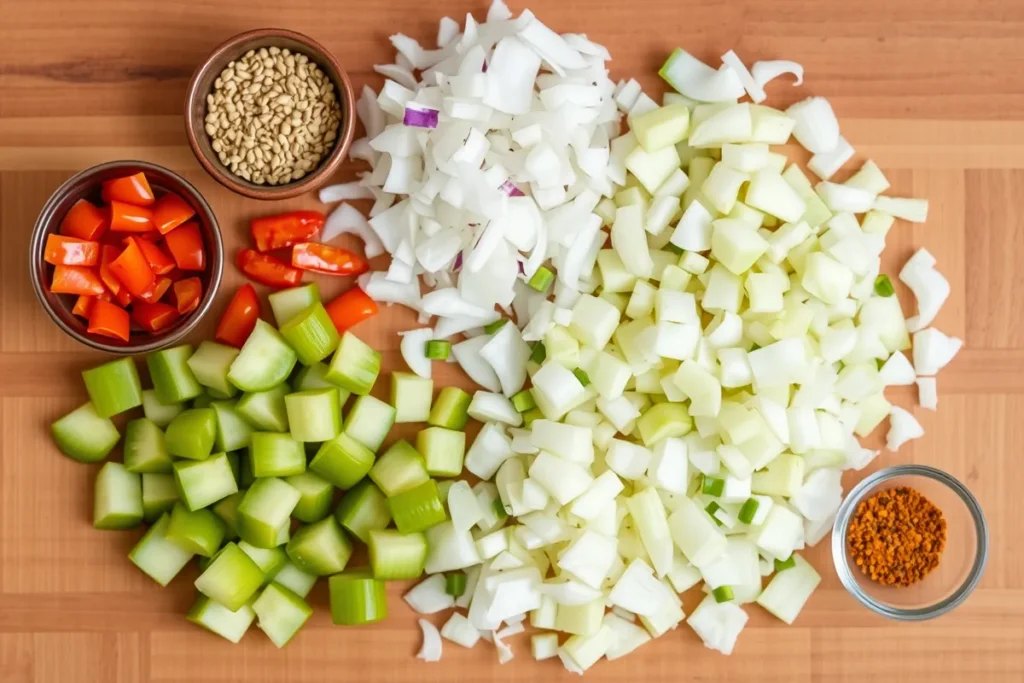
Core Ingredients
Primary Vegetables Used
When it comes to what chow chow is made of, its foundation lies in an assortment of vibrant vegetables. These ingredients not only contribute to the relish’s tantalizing flavor but also give it that unmistakable colorful appeal. From crunchy greens to zesty aromatics, every component plays a crucial role in creating chow chow’s signature taste.
Cabbage
Cabbage is a cornerstone of traditional chow chow recipes. Its crisp texture and mild flavor provide the perfect base for absorbing the tangy brine. Green cabbage is most commonly used, finely chopped to create a texture that blends seamlessly with the other vegetables. Its ability to retain its crunch after pickling makes it an irreplaceable ingredient.
Green Tomatoes
A touch of tartness comes from green tomatoes, which are often the unsung heroes of this relish. These unripe fruits deliver a bright, slightly sour taste that complements the vinegar brine beautifully. Plus, their firm texture ensures they hold up well during the pickling process.
Onions
Onions add a savory depth to chow chow, balancing the sweet and tangy notes. Both white and yellow onions are commonly used, their sharpness mellowing into a delicious, aromatic sweetness once pickled. The onion’s presence also enhances the relish’s overall complexity.
Bell Peppers
Bell peppers, whether green, red, or yellow, contribute both color and flavor. Their natural sweetness contrasts with the tangy brine, adding a touch of freshness to each bite. They’re often diced finely, ensuring that their flavor disperses evenly throughout the mixture.
Additional Vegetables in Regional Variations
Beyond the basics, regional variations of chow chow often incorporate extra vegetables, adding a unique twist to the recipe. These additions keep the relish dynamic and reflective of local culinary traditions.
Carrots
In some recipes, carrots are included for their subtle sweetness and vibrant orange hue. Shredded or diced, they add an appealing texture that makes the relish even more visually stunning.
Cauliflower
Cauliflower is a popular addition in Northern-style chow chow. Its firm florets hold up well during pickling and absorb the brine’s flavor, making them a delightful surprise in each bite.
Beans and Peas
Canadian chow chow often features green beans or yellow wax beans, offering a distinct texture and taste. Peas may also appear in this variation, lending a mild, sweet element to the mix. These legumes are a nod to the region’s agricultural bounty, adding a hearty touch to the relish.
By combining these vegetables, chow chow strikes a balance between tangy, sweet, and savory flavors, ensuring that each spoonful is as dynamic as it is delicious. The versatility of these ingredients means that no two batches are exactly the same—each one is a reflection of the maker’s creativity and taste.
Flavoring Components
Spices and Seasonings
The magic of chow chow doesn’t just come from its vibrant vegetables; its spices and seasonings are the true stars, turning a simple mix into a flavor-packed delight. These carefully selected ingredients enhance the relish’s tangy profile, creating the irresistible complexity that makes chow chow so beloved.
Mustard Seeds
Mustard seeds are a must-have in chow chow, bringing a warm, earthy sharpness to the relish. These tiny seeds not only infuse the brine with a spicy undertone but also add a satisfying texture. They’re a signature ingredient that’s found in nearly every chow chow recipe.
Celery Seeds
Celery seeds add a hint of herbal bitterness that cuts through the sweetness of the brine. Their subtle flavor is a great complement to the other spices, and their small size ensures they distribute evenly throughout the relish.
Turmeric and Other Spices
Turmeric is often included for its vibrant yellow hue and earthy flavor. It’s a natural addition to chow chow, lending both color and a subtle peppery note. Other spices, like cloves or allspice, may be added for depth, while red pepper flakes are used in spicier variations for a bold kick.
The Role of Vinegar
Vinegar is the backbone of chow chow’s brine, giving it the tangy punch that defines this relish. Its acidity not only preserves the vegetables but also enhances their natural flavors, making the chow chow taste both zesty and refreshing.
Types of Vinegar Used
The choice of vinegar can significantly influence the flavor profile. White vinegar is the most commonly used, providing a neutral tang that lets the vegetables and spices shine. Apple cider vinegar, on the other hand, adds a touch of fruity sweetness and complexity, making it a popular alternative in some recipes.
Balancing Acidity and Sweetness
One of the keys to a good chow chow is finding the perfect balance between acidity and sweetness. Sugar is often added to the brine to soften the sharpness of the vinegar, creating a harmonious blend of flavors. The exact ratio varies by recipe, but this balance ensures that every bite is a perfect marriage of tangy and sweet.
These flavoring components not only define chow chow’s character but also ensure that it remains a versatile addition to any meal. Whether you prefer it sweet, tangy, or spicy, the right combination of spices and vinegar can elevate the relish into something extraordinary.
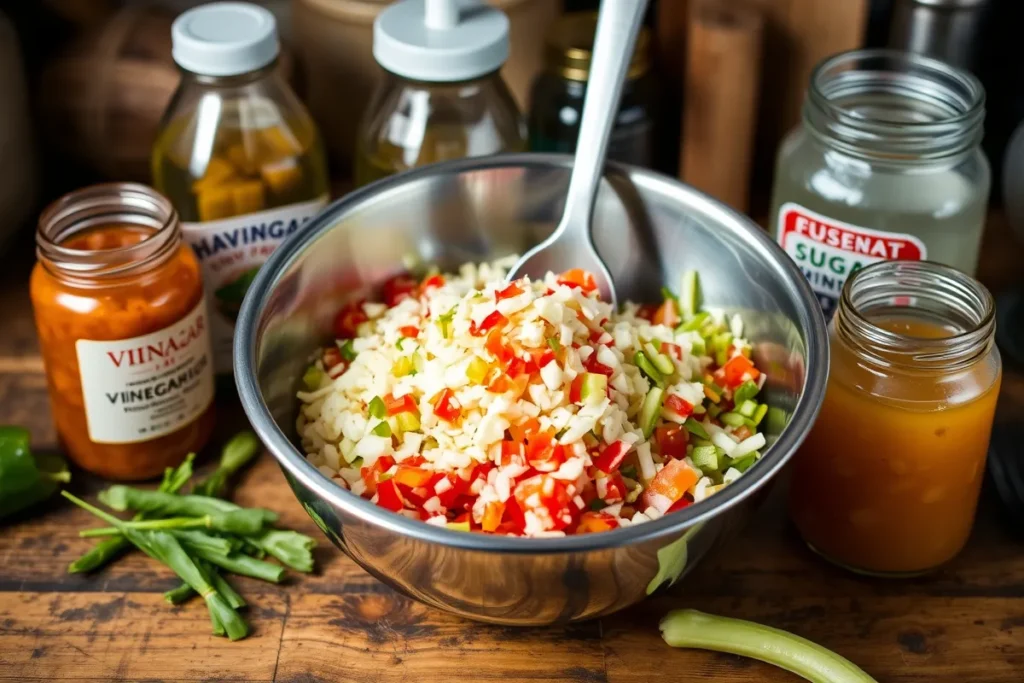
Regional Variations
Northern vs. Southern
Chow chow is beloved across many regions, but its recipe often varies depending on local tastes and traditions. While all versions share a common foundation, the differences in ingredients and flavors make each one unique. Let’s explore the nuances between Northern and Southern styles of chow chow relish.
Ingredients Differences
Southern chow chow is known for its slightly sweeter flavor profile, often using additional sugar to balance the tanginess of the vinegar. This version usually includes green tomatoes, cabbage, onions, and bell peppers, with some recipes calling for hot peppers to add a spicy kick.
In contrast, Northern chow chow leans more toward savory and tangy notes. It often includes vegetables like cauliflower and green beans, reflecting the region’s abundant produce. Less sugar is used in Northern recipes, and the focus is on bold, spiced flavors.
Flavor Profiles
The Southern version tends to have a smoother, sweeter taste with a bright, tangy finish. It’s commonly served as a complement to rich dishes like beans or barbecue. On the other hand, Northern chow chow is more robust and piquant, making it a flavorful topping for sandwiches or meats.
Both styles share the same essence but highlight how regional preferences can shape a dish’s identity, turning it into a reflection of local culture and history.
Canadian Maritime Chow Chow
In Canada’s Maritime provinces, chow chow takes on an entirely different personality. This version, often referred to as “green tomato chow,” showcases ingredients and flavors that are distinct from its U.S. counterparts.
Unique Ingredients
Canadian chow chow places a heavier emphasis on green tomatoes, sometimes excluding cabbage altogether. Other vegetables like yellow beans and onions also take center stage, resulting in a relish that’s lighter in texture and tangier in flavor.
The brine in Maritime chow chow is typically more acidic, with less sugar than Southern versions. Spices are kept simple, focusing on mustard seeds and vinegar to let the freshness of the vegetables shine.
Cultural Significance
In the Maritime provinces, chow chow is a staple during harvest festivals and family gatherings. It’s a reminder of the region’s agricultural roots, often made in large batches to preserve the season’s bounty. Served alongside hearty meals like boiled dinners or fish cakes, this version of chow chow is as much about tradition as it is about flavor.
Whether sweet and tangy, bold and savory, or refreshingly tart, the regional variations of chow chow demonstrate the adaptability and creativity of this beloved relish. Each version tells a story, connecting diners to the heritage and flavors of its origin.
Culinary Uses
How to Serve Chow Chow
Chow chow’s versatility is one of its greatest strengths. Whether you’re looking for a tangy topping, a savory side, or a way to elevate your dishes, this flavorful relish has countless uses in the kitchen. Let’s dive into some of the best ways to enjoy chow chow.
As a Condiment
One of the most popular uses for chow chow is as a condiment. Its tangy, slightly sweet flavor pairs beautifully with a variety of dishes. Try spooning it over hot dogs, burgers, or grilled sausages for an extra layer of zest. It’s also a classic topping for cornbread and fried green tomatoes, adding a sharp contrast to these rich Southern staples.
For something simpler, serve it alongside beans or peas. In Southern cuisine, chow chow is often used to brighten up a hearty pot of pinto beans or black-eyed peas, balancing their earthy flavors with its vibrant acidity.
Ingredient in Recipes
Chow chow isn’t just a topping; it’s also a fantastic ingredient. Mix it into coleslaws, potato salads, or pasta salads for a tangy twist. It can even be blended into dips or spreads for a zesty kick.
Looking for something heartier? Add chow chow to meatloaf or casserole recipes for a pop of flavor that will have everyone coming back for seconds. Its ability to enhance both simple and complex dishes makes it a must-have in any kitchen.
Popular Dishes Featuring Chow Chow
Chow chow has carved out a special place in the culinary world, particularly in Southern and Appalachian cuisines. Its bold flavors make it a star in both traditional and modern recipes.
Pairing with Southern Classics
Chow chow is a natural fit with classic Southern fare. Serve it with barbecue pulled pork, where its tangy notes cut through the rich, smoky meat. It’s also perfect for fried catfish, where its acidity balances the crunch of the fried coating.
In Appalachian cooking, chow chow is a staple at family dinners, often paired with stews or roasted meats. Its presence on the table adds a fresh, tangy element to hearty, comforting meals.
Modern Culinary Applications
Chefs and home cooks are finding new and exciting ways to incorporate chow chow into modern cuisine. They garnish avocado toast with it or layer it into grain bowls for a unique fusion of flavors. Its sweet and tangy profile also adds a surprising twist as a topping for gourmet pizzas and tacos.
From traditional dishes to contemporary creations, chow chow continues to shine with its incredible adaptability. Stick to classic pairings or experiment with new recipes—either way, this relish elevates any meal with its bold, zesty flavors.
In this version, the passive constructions have been removed or rewritten, ensuring that the active voice dominates the paragraph.
Health Benefits
Nutritional Value of Chow Chow
Chow chow isn’t just a treat for the taste buds—it’s also packed with nutritional benefits. Made from a variety of vegetables and flavored with spices and vinegar, this tangy relish can be a healthy addition to your meals. Let’s explore why chow chow deserves a spot on your plate from a nutritional perspective.
Vitamins and Minerals
The vegetables in chow’s, such as cabbage, green tomatoes, and onions, are rich in essential vitamins and minerals. For example:
- Cabbage: High in vitamin K, vitamin C, and antioxidants, which support immune health and reduce inflammation.
- Green Tomatoes: A good source of vitamin A, vitamin C, and potassium, promoting heart health and healthy vision.
- Onions: Contain compounds that help boost immunity and regulate blood sugar levels.
Together, these vegetables create a relish that’s both flavorful and nutrient-dense. Even in small amounts,can contribute to your daily vitamin and mineral intake.
Probiotics from Fermentation
In traditional recipes, some versions are fermented rather than cooked. This process introduces beneficial bacteria, known as probiotics, which support gut health. Fermented foods can improve digestion, enhance nutrient absorption, and even boost mental well-being.
Other Health Benefits
chow’s combination of vegetables, spices, and vinegar contributes to several other health perks:
- Low Calorie, High Flavor: With minimal sugar and no fat, chow’s is a low-calorie way to add a burst of flavor to your meals.
- Rich in Antioxidants: The vegetables and spices in chow’s are full of antioxidants, which combat free radicals and reduce oxidative stress.
- chow’s vinegar may help improve blood sugar control, especially when you consume it with carbohydrate-heavy meals
Enjoy it in moderation because of its sodium content, but don’t overlook its role as a flavorful, nutrient-packed condiment. It not only enhances gut health but also adds a pop of vitamins to your plate, offering something beneficial for everyone.
Frequently Asked Questions (FAQs)
When exploring what chow chow is made of, you might naturally have questions about its origins, preparation, and uses. Below, we answer some of the most common questions to help you better understand this unique relish
What is the origin of chow chow?
Historians debate the origins of chow’s, but many believe pickling traditions brought by immigrants to North America played a key role. Some trace its roots to Chinese pickled vegetables, while others point to European influences. Over time, it evolved into a distinctly regional dish in the Southern U.S. and Canada, where people celebrate its adaptability and flavor.
How long does homemade chow chow last?
When you properly can and store homemade a cool, dark place, it remains fresh for up to a year. After opening, refrigerate it and consume within two weeks to preserve its quality and flavor
Can chow chow be made without sugar?
Yes,can be made without sugar or with natural sweeteners as a substitute. Recipes that skip the sugar focus on the tangy and savory notes of the relish, making it a great option for those who prefer a less sweet flavor profile or have dietary restrictions.
Is chow chow gluten-free?
is typically gluten-free because it contains vegetables, vinegar, sugar, and spices. However, check the ingredients to confirm that it has no gluten-containing additives or preservatives
What dishes pair well with chow chow?
pairs beautifully with a variety of dishes. It’s commonly served with beans, peas, barbecue, sandwiches, and cornbread. Additionally, it works well as a topping for burgers or a tangy addition to dips and salads.
How spicy is chow chow typically?
The spiciness depends on the recipe. Southern variations often include hot peppers or red pepper flakes for a spicy kick, while Northern and Canadian versions tend to be milder, focusing on tangy and savory flavors instead.
These answers shed light on the versatility and cultural significance , while also addressing practical tips for its preparation and use. This relish remains a beloved addition to countless kitchens and cuisines worldwide.
Conclusion
is more than just a tangy relish; it’s a celebration of culinary creativity, regional traditions, and seasonal abundance. Whether it’s the sweet and savory Southern style, the bold Northern variation, or the tangy Maritime version, chow chow reflects the diverse flavors and cultural influences that make it special.
From its vibrant vegetables and bold spices to its versatile uses and health benefits, proves to be a kitchen essential that’s as nutritious as it is flavorful. It’s a condiment that bridges generations, transforming simple meals into memorable experiences.
